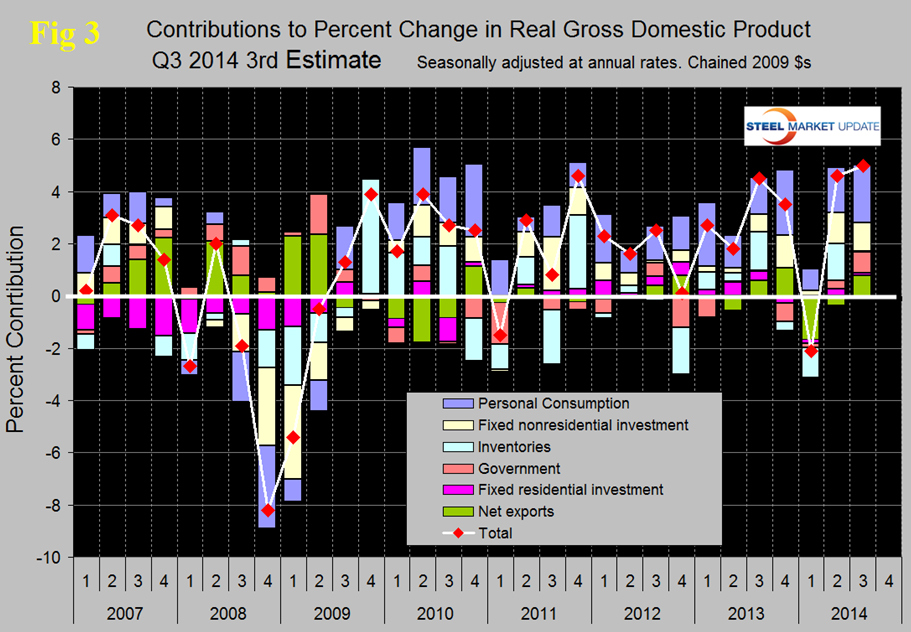Economy

Gross Domestic Product Q3 2014 Third Estimate
Written by Peter Wright
December 23, 2014
The article below is normally reserved for our Premium level members, but due to our holiday publishing schedule, we decided to share it with all of our readers. If you are interested in receiving our Premium product you may contact us at info@steelmarketupdate.com or (800) 432 3475.
The Bureau of Economic Analysis (BEA) released the third estimate of Q3 2014 Annual Revision of the National Income and Product Accounts on Tuesday.
The annualized growth rate in the 3rd Q was revised upwards from 3.50 percent in the 1st estimate to 3.9 percent in the 2nd estimate to 4.88 percent in the third estimate. GDP is measured and reported in chained 2009 dollars and in Q3 was $16.206 trillion. The calculation is slightly misleading because it takes the Q over Q growth and multiplies by 4 to get an annualized rate. This makes the high quarters higher and the low quarters lower, (Figure 1). On a year over year basis GDP was 2.70 percent higher in the 3rd quarter than it was in Q3 2013.
Figure 2 shows the publicized quarterly results since 1990 and the latest IMF forecast through 2018. The reported GDP growth in the 2nd and 3rd quarters were the best back to back results since 2003. Based on the strong Q2 result, the IMF increased its forecast for the US in the October World Economic Outlook report, no doubt there will be another upward revision in the April 1025 WEO report.
Figure 3 shows the change in the major sub-components of GDP.
Comparing Q3 with Q2 there were major changes in the sub-components. Personal consumption and fixed residential investment were both up by 3.2 percent. Personal consumption includes goods and services, the goods portion of which includes both durable and non-durables. In the 3rd Q personal consumption accounted for 67.9 percent of total economic activity, exactly the same as Q3 last year. Fixed nonresidential grew by 8.9 percent, durable goods grew by 9.2 percent and government grew by 4.4 percent. Inventories which had contributed 1.42 percent to the 2nd Q result contributed only 0.03 percent in Q3. Increasing inventories make a positive contribution to GDP and over the long run inventory changes are a wash and simply move growth from one period to another. Net exports which had a negative contribution of 0.34 percent in Q2 made a positive contribution of 0.78 percent in Q3. Figure 4 shows the breakdown of the $16 trillion economy.
The official press release from the BEA reads as follows:
Gross Domestic Product: Third Quarter 2014 (Third Estimate)
Real gross domestic product — the value of the production of goods and services in the United
States, adjusted for price changes — increased at an annual rate of 5.0 percent in the third quarter of 2014, according to the “third” estimate released by the Bureau of Economic Analysis. In the second quarter, real GDP increased 4.6 percent. The GDP estimate released today is based on more complete source data than were available for the “second” estimate issued last month. In the second estimate, the increase in real GDP was 3.9 percent. With the third estimate for the third quarter, both personal consumption expenditures (PCE) and nonresidential fixed investment increased more than previously estimated.
The increase in real GDP in the third quarter primarily reflected positive contributions from
PCE, nonresidential fixed investment, federal government spending, exports, state and local government spending, and residential fixed investment. Imports, which are a subtraction in the calculation of GDP, decreased.
The acceleration in the percent change in real GDP reflected a downturn in imports, an upturn in federal government spending, and an acceleration in PCE that were partly offset by a downturn in private inventory investment and decelerations in exports, in state and local government spending, in residential fixed investment, and in nonresidential fixed investment.
SMU Comment: We have reported frequently in the past on the relationship between GDP and steel consumption. Steel growth follows economic growth but is very much more volatile. In addition over the long run about a 2.5 percent growth of GDP is necessary to get any growth in steel consumption. In four of the last five quarters, GDP growth has been well above 2.5 percent which bodes well for future steel demand.

Peter Wright
Read more from Peter WrightLatest in Economy

ISM: Manufacturing expansion loses steam after two months of growth
US manufacturing activity slowed in March after two straight months of expansion, according to supply executives contributing to the Institute for Supply Management (ISM)’s latest report.

Chicago Business Barometer rose to 16-month high in March
The Chicago Business Barometer increased for the third-consecutive month in March. Despite this, it still reflects contracting business conditions, as it has since December 2023.

Durable goods orders rise again in February
Transportation equipment led the increase, rising 1.5% to $98.3 billion.

Consumer confidence falls for fourth consecutive month
People remain concerned about inflation, trade policies, and tariffs.

Housing starts ticked up in February
Single-family starts last month hit a rate of 1.10 million, a month-over-month increase of 11.4%, census data shows.




